7 membership pricing strategies for maximizing revenue
You’ve built—or are building—a valuable membership community. Now, how much should you charge for it?
We understand that this question may feel daunting because you don’t want to overcharge, undercharge, or risk churned members. But the way you charge people for being “in the inner circle” (pun intended) is directly tied to your community ROI.
That’s why we recommend thinking of your membership pricing as a strategy, not just a number.
Want to set a price point that matches your audience and drives revenue without guesswork? Follow the best practices in this post and our community pricing guide.
What is membership pricing (and why is it different from subscriptions)?
Membership pricing refers to the recurring fee that customers or members pay for ongoing, exclusive access to products, services, discounts, content, or a community. You can charge this fee as regularly as needed: monthly, quarterly, or yearly.
You’ll often see memberships with gyms, clubs, loyalty programs, and subscription boxes, but they’re also incredibly effective for communities.
Subscription pricing ensures consistent access to a valuable offering, unlike community memberships that provide a sense of belonging and additional benefits.
| Membership Pricing | Subscription Pricing |
|---|---|
| Often involves belonging to a community and receiving exclusive perks, like discounts, early access, or member-only events. | Entails paying periodically to access a product or service, e.g., courses or paywalled content. No community element. |
The psychology behind membership vs subscription pricing
The psychology behind memberships vs subscriptions is nuanced.
For example, in memberships, if people pay monthly, they expect to receive value every month. For subscriptions, however, one study found that almost 70% of consumers often subscribe to services they then forget about or rarely use—a “set it and forget it” mentality.
Also, if people feel like they don’t fit in socially (in memberships), then they’re more likely to cancel. Hence, the onus is on the community manager to create an onboarding flow that makes members feel welcome. Whereas, for a subscription, if the value subscribers are getting from it (say a financial app or editing tool) is good, then all is well. There’s less emphasis on emotions.
Both drive recurring revenue, but there are some emotional and community-based differences:
- Memberships give a sense of community belonging and identity. They also signal access, transformation, and relationship. Meanwhile, subscriptions lean into the content or product access mindset.
- Subscriptions are more transactional and one-and-done, but memberships rely on social proof and status factors to generate income while still building strong emotional connections.
The summary? Both membership and subscription pricing involve frequent payments, but with memberships, the sweet spot is making people see and feel that they are getting more than their money’s worth.
Pricing when you're the product
If you’re building a membership program on top of a successful personal brand, your pricing approach may differ from communities built around shared pains or aspirations.
Because if you’re the brand, you’re not just charging for content, resources, or support—you’re putting a price tag on access and proximity to your expertise, perspective, and presence. So your pricing is about how close members feel to you, not just what they can get from the group.
Some key considerations to keep in mind:
- Personal brand vs community value: With a community based on a personal brand, the draw is you—your voice, story, and credibility and authority in your space. And your members are those who are aligned with your shared mission or perspective. That means your pricing should reflect that the value is more relational than communal.
- Time-based vs value-based pricing for personal access: Your presence is a key part of the offer, so pricing may depend on the amount of direct access members get to you, rather than the value of your resources. The more access, the higher the price, like in VIP tiers, mastermind groups, office hours, one-on-one coaching, and more.,
- Scaling limitations and pricing implications: Your time doesn’t scale infinitely. You still have the same 24 hours as everyone else. Hence, the more personalized or intimate the access, the more you’ll need to price accordingly. For example, if you’re a coach, you can’t continue to take on 1:1 clients forever, but you could expand your offer to group coaching programs.
The membership pricing ladder—choose the right starting point
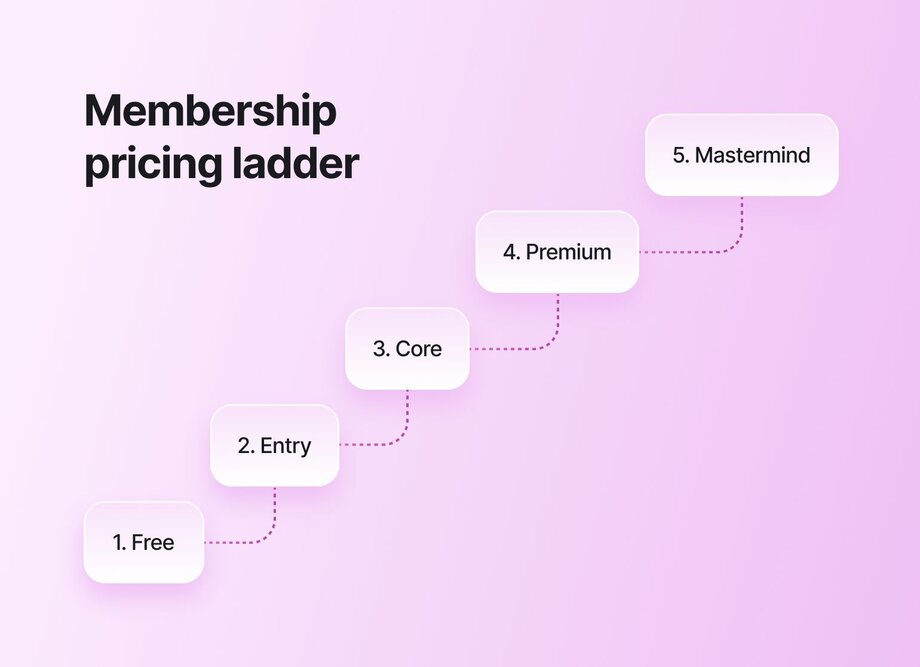
There is no right or wrong way to price your membership program, but certain pricing models tend to work better at specific stages or for different audience types.
Note: You can combine two or more models as needed.
- ⚖️ Flat fee: Charge everyone a single, recurring price. Best for: Simple, scalable communities with one clear offer—especially early-stage programs or content-led memberships.
- 📶 Tiered pricing: Offer multiple pricing tiers with different benefits (e.g., content-only vs. 1:1 founder access or exclusive event invites). Best for: Communities with mixed audiences—people who want low-commitment entry vs those craving premium access.
- 👐 Pay-what-you-want: Allow members to choose how much to pay, though you can suggest a minimum amount. Best for: Audience-first or mission-led communities that lead with accessibility, trust, or donation-based models.
- 🚀 Founding member discount: Give early access at a lower price to your first set of members. Best for: Building initial traction, validating your idea, and rewarding your most loyal supporters.
5 real-world pricing examples from Circle creators
Some real-life membership fee examples from our network include:
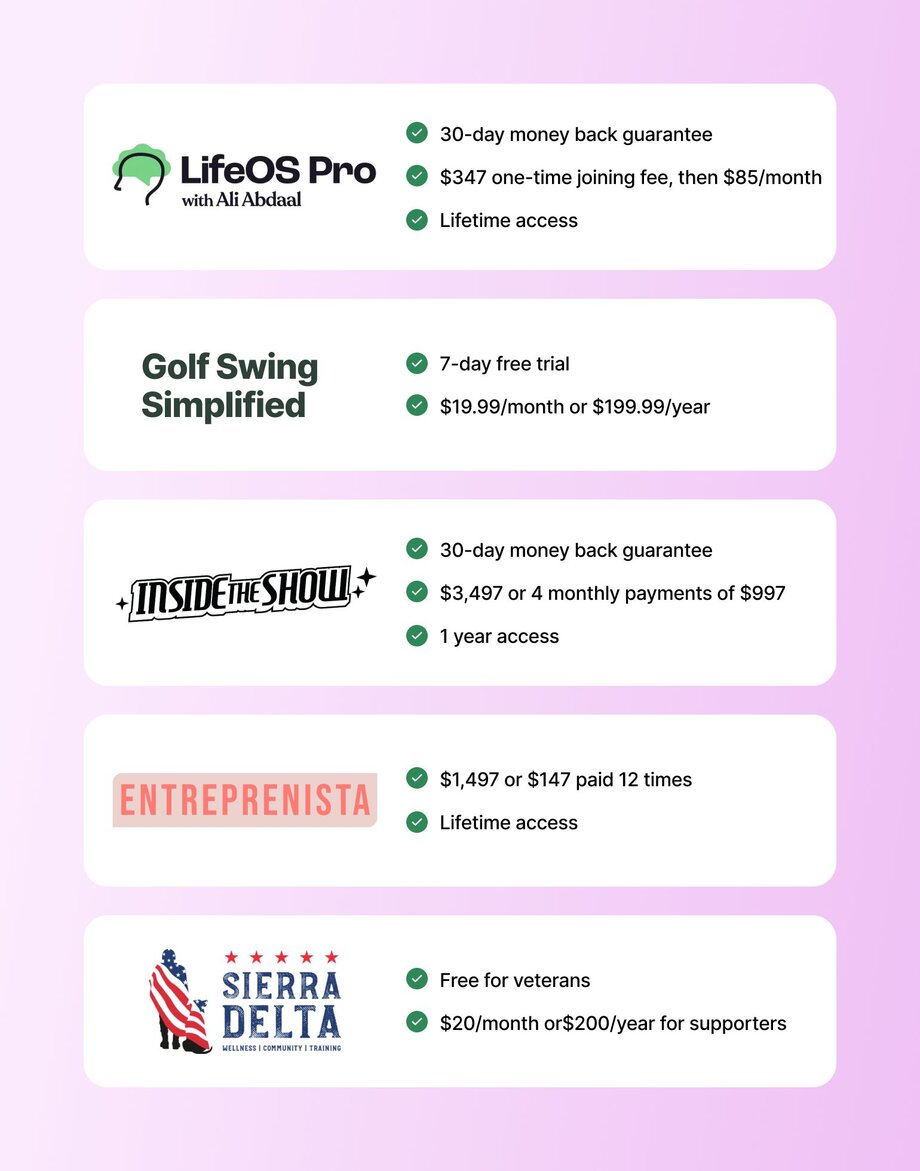
6 advanced pricing strategies for solopreneurs and branded communities
Determining the best price point for your membership offering requires critical thinking, research, and sometimes, a bit of trial and error.
Note: Mix and match as needed.
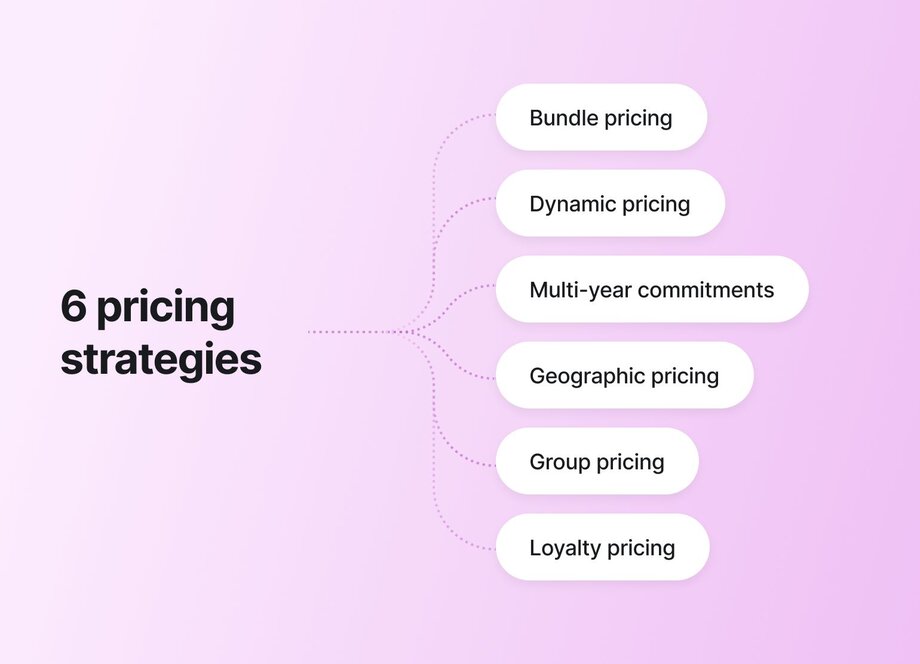
Bundle pricing
Bundle pricing involves combining multiple offerings into a single payment plan, e.g., community plus courses, coaching, and content. It’s worth considering because it gives prospects a lot to look forward to when they join, while driving higher revenue per customer for you.
Examples of bundle pricing
- Courses + community: Vocal training programs + a supportive virtual community for $97.99/month or $999.99/year.
- Membership tiers + community: Web design courses, community, and coaching, attracting monthly payments of $49, $99, and $199, respectively.
- Content library + live support: An ever-growing bank of diabetic-friendly recipes with access to pre-vetted volunteer chefs who can guide cooking activities, all paid for by donations of $20 or more.
Dynamic pricing
Dynamic or demand-based pricing is all about contextual price adjustments that help all sides, which is very different from price gouging.
This approach can help you stay flexible during slower periods or key events, so you can earn while aligning with member needs.
Examples of dynamic pricing
- Seasonal price adjustments—or, sales: A community focused on preserving African-American heritage might charge $50/month or $500/year but could offer a 25% discount to new members (and renewals!) during Black History Month.
- Cohort launches: A 3-month weight loss program could become so successful that the price increases to serve the rising demand. For example, the first cohort may launch at $500, but relaunch later at $750 and $1000 per person.
- Member lifecycle pricing: A gardening group offering a 10% lower price to new or trial members to lower the barrier to entry. Or, offering at-risk members 50% off their annual subscription to prevent churn.
💡 Member lifecycle pricing refers to adjusting your membership prices based on the stage someone is in their journey with your community or product. It boosts retention, conversion, and revenue by accounting for different stages like:
- New members: Introductory or trial pricing to lower the barrier to entry.
- Engaged or loyal members: Standard or premium rates, as they see more value.
- At-risk or inactive members: Re-engagement offers or discounts to win them back.
- Long-term members: Loyalty pricing, perks, or renewal bonuses.
Multi-year commitments
Multi-year commitments encourage members to stay deeply invested in your community and its long-term success. They generate predictable annual recurring revenue (ARR) and help you plan with money that you actually have in the bank, not just projections.
They also drive near-failproof retention. After all, no one wants to pay for something and not use it, especially if it costs a pretty penny.
That said, this dynamic can actually make multi-year commitments easier to manage from an operational standpoint because people have already paid—similar to how a gym membership with autorenewal keeps running even when members aren't actively using it. The upfront financial commitment creates a psychological barrier to leaving, even during periods of lower engagement.
Examples of multi-year commitments
- Annual discounts: A book club and co-working group offering 15% off for 2-year memberships.
- Early-bird offers: Mindful living community charging $200/year (instead of the standard $300/year paid annually) for early sign-ups who commit to 3-year plans.
- Exclusive perks: A developer hub that gives free premium content, discounted event tickets, and tool coupon codes to those on a 4-year plan.
Geographic pricing
Consider location-based pricing if your audience spans regions with varying currencies, income levels, or purchasing power. It’ll help you stay inclusive and competitive, especially as a global community where flat rates could be too high or too low for certain markets.
By accounting for geographic differences, you create fairer access without leaving money on the table.
Examples of geographic pricing
- Currency factors: A project management mentorship club may charge $100/month in the U.S., but offer the same plan at NGN 75,000/month (the equivalent of ~$50 USD) in Nigeria, reflecting both currency conversion and local affordability. This compromise would make sense since, as of 2023, the average per capita income in the U.S. was $82,769.4 while Nigeria’s was $1,596.6.
- Regional considerations: UK-focused wellness community setting a higher price (£60/month) for members in London due to local average income benchmarks, while maintaining a lower tier (like £45/month) for Leicester and Bradford. This scenario is less likely since all regions are within the same country, but it’s still worth considering.
- Purchasing Power Parity (PPP): A group for serial entrepreneurs, with chapters or channels for different countries, might bill differently based on World Bank PPP data, e.g., $40/month in India vs $80/month in Switzerland.
Group or corporate pricing
Group or corporate pricing is ideal for communities that companies are likely to expense for employee development. It’s a win-win B2B strategy because businesses get bulk discounts, while you gain predictable, scaled growth (even if your per-head revenue is slightly lower).
Examples of group/corporate pricing
- Basic team discounts: A community for agency leaders offering a 20% discount on their regular price of $80/month per member for group signups (5 or more).
- Bulk memberships: A real estate agent network could charge members a one-time joining fee of $250 and subsequent monthly payments of $60, offering a negotiable enterprise pricing tier for 10 or more agents from the same company.
- Volume-based discounts: Workplace wellness society with a tiered discount structure where the cost per member reduces as more people from the same organization sign up. E.g., 1-5 employees pay $100/month, 6-15 pay $75/month, and 16+ pay $50/month.
Loyalty or tenure-based pricing
Loyalty or tenure-based pricing is a form of member lifecycle billing, where communities charge long-term clients less than regular or new ones. It is based on the premise that rewarding your best members can help reduce churn, enhance retention, and drive referrals.
Examples of loyalty/tenure-based pricing
- Legacy pricing: A yoga community could lock in a $30/month rate for founding members, even as new clients pay $50/month.
- Renewal discounts: Design mentorship hub offering 14% off to members who extend their annual plan for a second or third year.
- Milestone perks: No-code learning group may give long-term members access to bonus courses or 1:1 coaching after 12+ months of active membership.
5 pricing tests you can run in Circle
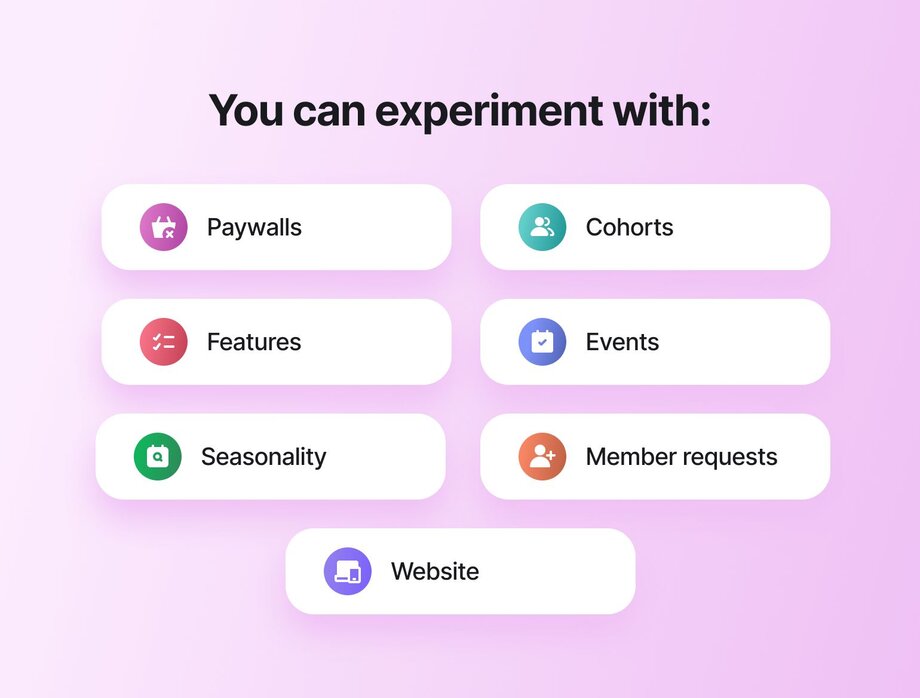
Want to experiment with different pricing models to find the right combo for your members? Circle’s membership management software lets you run insightful tests like:
- Cohort pricing experiments: Adjust the prices of your community paywalls as you launch new cohorts to find the ideal price that converts best.
- Seasonal pricing tests: Try updating your prices during specific periods or events—like Mother’s Day for parenting communities, Mental Health Month for wellness memberships, or your business anniversary—which give you a chance to offer coupons or special rates without undervaluing your membership program.
- Feature-gated pricing tests: Experiment with gating specific membership features, like access to premium courses or one-on-one mentorship. You can do this via your community’s landing page by providing different options for prospects to choose from when signing up.
- Member feedback-driven pricing adjustments: Once you’ve tried out one or more pricing models, observe your conversion numbers and ongoing member conversations (within and outside the community). These insights will help you decide whether to adjust your price up or down. You can also run polls with members to create a value matrix that’ll help you decide what features go in higher tiers.
- A/B testing landing page pricing: Test different copy, visuals, and CTAs to identify what resonates most with your audience and increase revenue. Key metrics to track for effective optimization include page traffic, engagement, conversions, and retention. Either run the tests via Circle paywalls or try external testing tools like VWO.
Circle features that support your flexible pricing strategy
It’s not always easy to find a tool that helps you manage your memberships, events, discussions, analytics, and finances. But when you find the right one, it can be revolutionary.
67% of community builders plan to consolidate their tech stack in 2025, including CRMs, email marketing platforms, and automation tools.
So let’s take a look at some of the key Circle features that will support any pricing strategy you choose:
Automated tier management: Circle lets you set up a membership paywall with tiered subscription groups. This way, members get to choose their most convenient option.
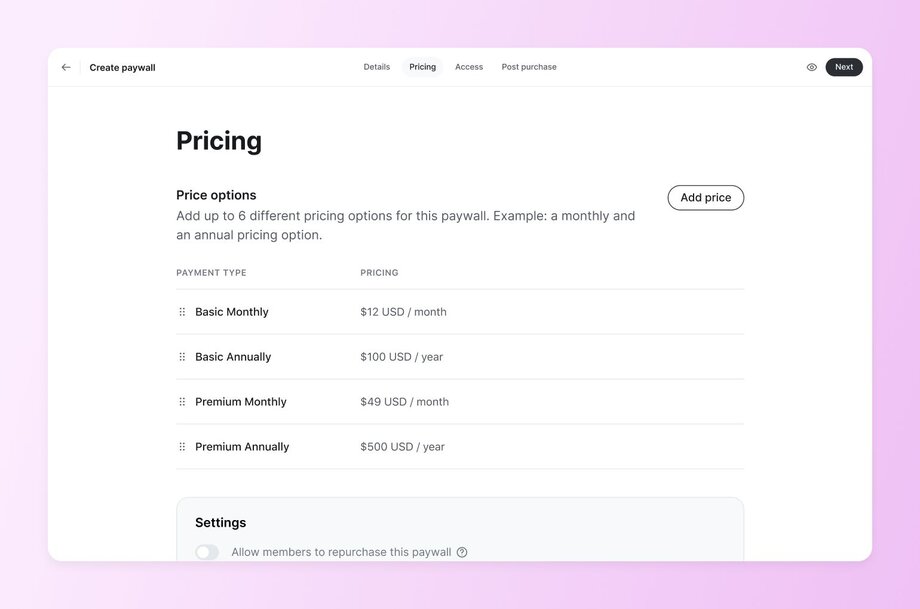
Member segments for pricing tiers: With Circle tags and workflows, you can group members and give them unique experiences, campaigns, and dashboard views based on their membership plan.
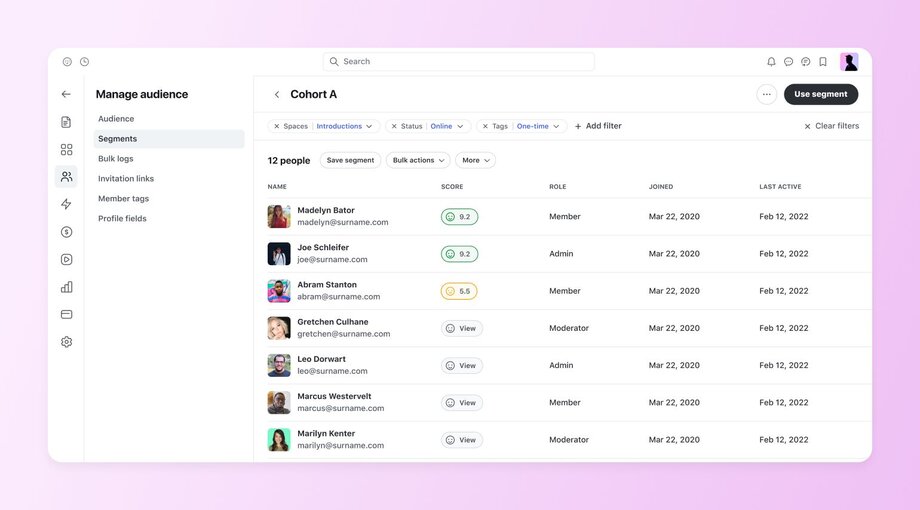
Content gating and access control: Controlling how much access members on different payment plans get to content, spaces, or other benefits doesn’t have to be difficult. Simply use our access groups feature to control how members enter spaces in your community.
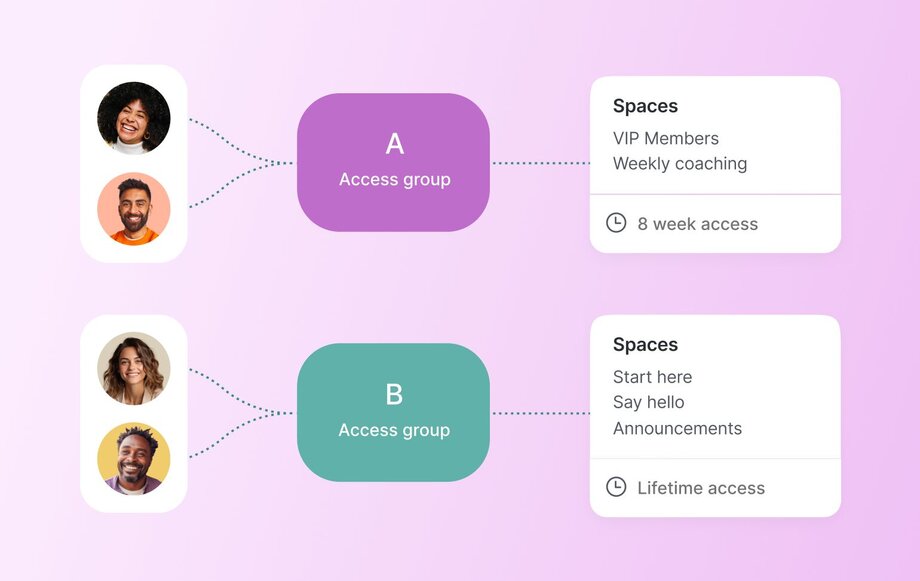
Payment integrations and custom paywalls: You could create your pricing page elsewhere and embed a Circle paywall on it. But with our page builder, you’ll have more control over your purchase funnel. It offers advanced customization features and full-funnel analytics that show you what resonates best—from first impression to repeat member—so you can double down on it.
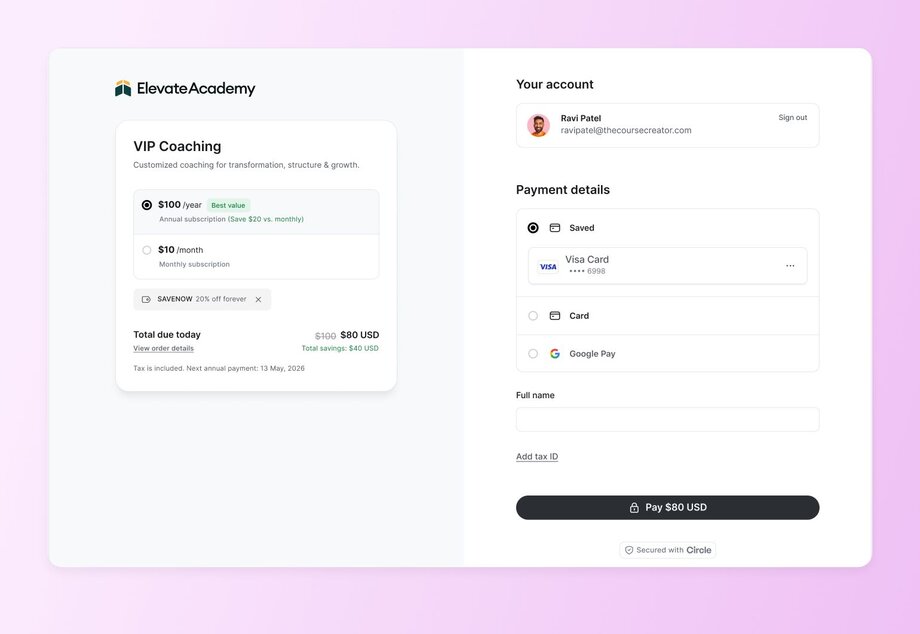
Analytics for conversion optimization: Wondering about monitoring results? Don’t be. On Circle, you can track your pricing page views, conversions, bounce rate, and visitors. Improve your offer and boost conversions with these insights.
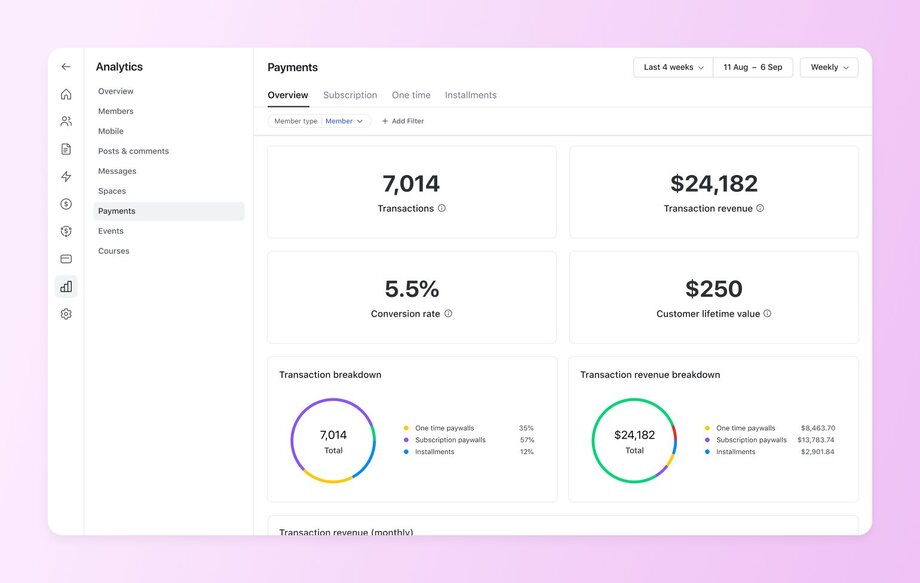
Use our membership pricing calculator to get unstuck
Pricing your community membership appropriately is difficult. If it were easy, you’d have done it and moved on to other things.
Because setting your membership price can be a make-or-break decision, it relies on key factors like revenue goals, member projections, and community trends.
That’s why we created a free tool to help.
Membership pricing mistakes that kill retention
Memberships can be a powerful part of your community monetization strategy—but only if they’re priced right. Get it wrong, and you risk low conversions, poor retention, or worse: realizing too late that you’ve been leaving serious money on the table.
The good news? Most membership pricing mistakes follow similar patterns. Here are the four most common ones we’ve observed and how to avoid them without missing a beat:
Pricing too low and devaluing the community
Low prices may attract more signups at first, but they could also signal low value, attract the wrong audience, or cause low engagement. So instead of just slapping on a low price, bill according to the transformation or access you offer. Trust us—people pay more when they believe it’s worth more.
Still unsure? Here are four reasons to raise your prices, according to Circle expert and founder of Build a Community Business Tatiana Figueiredo:
- Freemium and low-cost tiers are risky, and people rarely upgrade because they join with limited access and immediately feel disconnected or unable to fully engage.
- People are more invested when they’ve paid more, leading to better experiences.
- Lack of boundaries can make you feel resentment towards your community, but pricing helps you protect your time and energy.
- Meaningful connection is worth paying for—and your pricing should reflect that.
Surprise price increases without grandfather clauses
Suddenly upping your price without honoring early supporters can break trust and lead to churn. This is why you should grandfather existing members, i.e., let them keep their original rate despite price increases.
Like in the case of Trend Atelier, founder Geraldine Wharry doubled the community membership fee after realizing how much effort her high-value events were taking. But first, she grandfathered her first two cohorts, whom she didn’t want to catch unaware.
If you can’t do that, go the route of clearly communicating upcoming changes with an extended notice period so they aren’t caught off guard.
Not aligning pricing with member journey stages
Charging beginners and seasoned members the same rate doesn’t account for their evolving needs. So, rather than doing that, meet everyone where they are by considering tiered pricing or add-on upgrades that match each person’s member journey stage.
For example, Self-Care Society offers a few one-time payments for live events, and three main offerings:
- 7-day confidence challenge: $7
- All-access membership: $12/month
- “You Year” 4-hour course: $97
Ignoring payment psychology (billing dates, amounts)
Random or poorly-timed charges (e.g., mid-month) can increase cancellations. Seriously. The last thing anyone wants is a surprise “maintenance” fee after their standard payment, or a bill hitting when they’re low on funds and waiting for payday.
Avoid these issues and reduce friction by using a timely billing date (like the 1st or last day of the month), offering monthly vs. annual plans, and aiming for clear, easy-to-justify pricing.
Pricing is a journey, not a one-time decision
But confidence in your price point at any stage comes from clarity, testing, and member insight.
Enter Circle, the best platform for testing, scaling, and monetizing communities. Use our app to launch or upgrade your paid membership program, starting with a free 14-day trial (so you can see for yourself!)
FAQs
What is an example of a membership fee?
A membership fee could be a monthly $25 charge for access to a community and exclusive content. However, some membership fees can go up to $1000 or more.
How do I set a membership fee?
Consider your offer, expenses, and what others are charging to determine the right membership fee. Try our free community ROI calculator to see what a particular fee and audience size looks like based on average conversion rates pulled directly from real Circle communities.
What's the difference between a subscription and a membership?
A subscription usually grants access to a product or service for a defined period, while a membership typically includes community engagement.
Should I offer a free community tier?
A free community tier may attract new members, but it could also limit engagement and revenue potential. So if possible, use it as a funnel to paid tiers.
How to price membership tiers for maximum revenue?
Offer tiered membership pricing based on the value you’re providing—e.g., lower-cost entry options for beginners and higher-value options for advanced members or premium benefits.
How do I test my membership pricing?
A/B test different price points and track conversions, churn, and member feedback to find the optimal amount.
How do I calculate membership pricing for my online course?
Calculate membership pricing for your online course by factoring in its value, competitor prices, target audience affordability, and the overall experience you’re offering.
Should I offer lifetime membership pricing?
Lifetime pricing can provide upfront revenue but may hurt long-term ROI and member retention. Consider offering it selectively, e.g., for founding members, a limited-time offer, or a certain number of members.